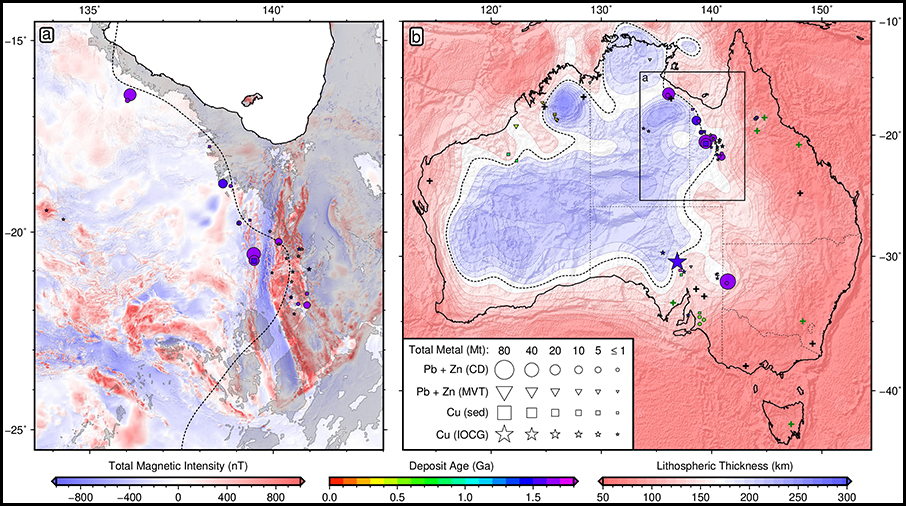The search for deposits of lead, zinc, copper, and nickel might soon become much less of a hit-and-miss activity. Instead of trying their luck over wide areas, mining companies should focus their efforts—and billions of dollars in exploration expenses—on the contours of thick, old pieces of lithosphere strewn across Earth’s continents: cratons.
Lithospheric thickness can serve as a treasure map, according to Mark Hoggard, an Earth scientist at Harvard University and Columbia University, and his colleagues from the United Kingdom and Australia. They reported their findings in Nature Geoscience.
Hunting for Giants
Metals are ingredients of many rocks, but to be exploitable, some process must concentrate them into localized deposits. For lead, zinc, copper, and nickel (collectively known as base metals), such deposits are either magmatic, associated with volcanism, or sedimentary, associated with material collected at the bottom of an inland body of water.
Sedimentary deposits generally provide the biggest jackpot for mining companies, with some finds containing more than 10 megatonnes of metal. With magmatic deposits, only those of copper seem to be able to reach that size.
Such giant deposits are sorely needed. “At the moment, due to massive advances in mobile technology and the need to decarbonize the global economy, we are needing more and more metals,” said study coauthor Fred Richards, an Earth and planetary scientist at Harvard University and Imperial College London. In-demand metals include “lead, zinc, copper, and nickel, but also lots of other metals that are accessories to these big deposits, such as cobalt, which goes into car batteries.”
Considering that about three quarters of the world’s continents are covered by sedimentary basins, knowing to start looking there is of little help in detecting giant deposits. A first hint at how to limit the search space came from northern Australia, where Hoggard and his colleagues noticed that a number of large zinc deposits line up rather neatly along an arc. But it wasn’t clear what geological feature was connected to that shape.
The group had been working on improved models of how seismic waves travel through Earth’s interior. The results of their work provided a new map of Australia’s lithospheric thickness—and suggested an explanation for that arc of zinc deposits. The line skirted the large craton that makes up the west of the continent.

Intrigued, the researchers investigated the geography of deposits and cratons in all of Australia, and then worldwide, and found many such juxtapositions. A statistical analysis confirmed that what they saw was not due just to chance.
Circulating and Scavenging
But what makes large base metal deposits so likely to snuggle up to cratons? It turns out that such a location provides a whole slew of circumstances that facilitate the process of concentrating metals.
That process generally starts with an inland sea becoming increasingly salty through evaporation. In the shallowest parts of the sea, the concentration will become so high that salts precipitate to the seafloor. When compressed by subsequent layers of sediment, these precipitates turn into salt rocks, such as gypsum, anhydrite, and halite.
Seawater then percolates down through the salt rocks and very slowly, with speeds measured in meters per year, travels through faults into deeper rocks. If the heavy, briny fluid passes through oxidized rocks, it becomes oxidized itself, and as a result, it is easy for metals in the rocks to dissolve into the brine and be swept up with it. The resulting metal-rich fluid has been observed, for instance, below the Salton Sea in California.
As the brine descends, it comes closer to the hot underside of the lithosphere and heats up and expands. This makes it less dense and thus more buoyant, to such an extent that it rises up again, until it cools—just enough to start to sink again. The brine may keep circulating in this way through sedimentary layers for long periods (there is some debate whether those periods are millions of years at a stretch or come in shorter bursts), scavenging metals as it flows.
But sometimes brine passes through an environment that is reducing, meaning it counteracts the oxidized state of the fluid. In this case, metal finds it harder to stay dissolved in the brine, and some of it will precipitate out. Black shales, for instance, composed of mud sediments laid down in deeper portions of the inland sea, provide just such conditions, and build up metal deposits in their interstices.
Digging Deeper
Cratons are deep, extratough regions of the lithosphere. They don’t typically lend themselves to thinning or rifting. But that very resistance makes their edges likely places for thinning of the weaker surrounding lithosphere, and thus perfect for forming sedimentary basins.
Such basins might even get stacked atop each other, as the lithosphere cycles through stretching and compressing phases. Weakened by the previous events, the edge will give way again and again, possibly allowing metal deposit formation.
The lithosphere at a craton’s edge is still thicker than elsewhere on a continent, so stretching and thinning it take longer. The slowness of the process gives the brine more time to circulate, and the remaining thickness of the stretched craton’s edge gives it a longer way to go down before temperatures get too high for the metal precipitation processes to work. These circumstances increase the volume of the deposit.
The research documenting deposits on the craton’s edge clearly has practical implications. According to Hoggard, “our maps work everywhere, including in continents where a geologist’s boot rarely hits the ground—for instance, in parts of Africa and Antarctica—and we can provide an actual probability that a deposit exists, which is what companies need to make financial decisions.”
And according to the scientists, the research also provides evidence for the stability and longevity of cratons. For instance, some sedimentary metal deposits in North America have been dated to 0.5–1.5 billion years old. For at least that long—apparently while continents broke up, collided, and joined up again—the craton against whose edge these deposits were nestling stayed in one piece.
It’s good research, according to Jon Hronsky of the mineral exploration consultancy Western Mining Services, which has offices in the United States and Australia. “However, it is a little bemusing to us in the mineral exploration geoscience community that this is the first time these sort of ideas are finally gaining some attention from the general geoscience community,” he told Eos in an email.
According to Hronsky, “the idea that deep-seated cryptic patterns of weaknesses and discontinuities in the lithosphere control the location of major ore deposits is quite an old one,” and “concepts, relating lithospheric architecture to the location of major mineral deposits, have been fairly central to mineral exploration targeting, at least within the more progressive companies, for about two decades.”
Hoggard agrees with that as far as magmatic deposits are concerned. But according to him, such relationships so far had not been established for sedimentary deposits. “The data sets we use to image lithospheric structure have only really become available within the last 10 years. Even if someone had an inkling of the relationship before now, they wouldn’t have been able to test it like we can today.”
—Bas den Hond ([email protected]), Science Writer






